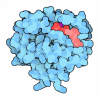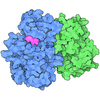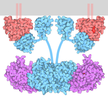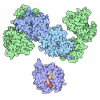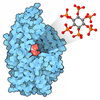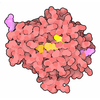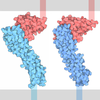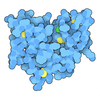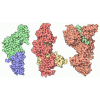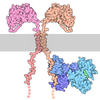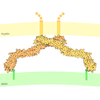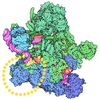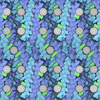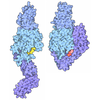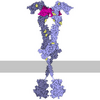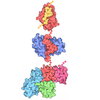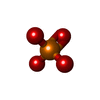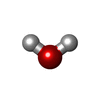| 登録情報 | データベース: PDB / ID: 6atd
|
|---|
| タイトル | Oxidized SHP2 forms a disulfide bond between Cys367 and Cys459 |
|---|
 要素 要素 | Tyrosine-protein phosphatase non-receptor type 11 |
|---|
 キーワード キーワード | HYDROLASE |
|---|
| 機能・相同性 |  機能・相同性情報 機能・相同性情報
negative regulation of cortisol secretion / intestinal epithelial cell migration / microvillus organization / negative regulation of growth hormone secretion / genitalia development / atrioventricular canal development / negative regulation of cell adhesion mediated by integrin / STAT5 Activation / Co-inhibition by BTLA / Netrin mediated repulsion signals ...negative regulation of cortisol secretion / intestinal epithelial cell migration / microvillus organization / negative regulation of growth hormone secretion / genitalia development / atrioventricular canal development / negative regulation of cell adhesion mediated by integrin / STAT5 Activation / Co-inhibition by BTLA / Netrin mediated repulsion signals / cerebellar cortex formation / negative regulation of neutrophil activation / positive regulation of hormone secretion / regulation of protein export from nucleus / positive regulation of ossification / positive regulation of lipopolysaccharide-mediated signaling pathway / Interleukin-37 signaling / Signaling by Leptin / hormone metabolic process / MET activates PTPN11 / Regulation of RUNX1 Expression and Activity / negative regulation of chondrocyte differentiation / face morphogenesis / Signal regulatory protein family interactions / ERBB signaling pathway / platelet formation / Interleukin-20 family signaling / Interleukin-6 signaling / organ growth / triglyceride metabolic process / megakaryocyte development / negative regulation of type I interferon production / peptide hormone receptor binding / PI-3K cascade:FGFR3 / Co-inhibition by CTLA4 / MAPK3 (ERK1) activation / Platelet sensitization by LDL / STAT5 activation downstream of FLT3 ITD mutants / PI-3K cascade:FGFR2 / PI-3K cascade:FGFR4 / PI-3K cascade:FGFR1 / MAPK1 (ERK2) activation / Prolactin receptor signaling / regulation of cell adhesion mediated by integrin / regulation of type I interferon-mediated signaling pathway / PECAM1 interactions / inner ear development / neurotrophin TRK receptor signaling pathway / Bergmann glial cell differentiation / Regulation of IFNA/IFNB signaling / positive regulation of intracellular signal transduction / peptidyl-tyrosine dephosphorylation / platelet-derived growth factor receptor signaling pathway / phosphoprotein phosphatase activity / RET signaling / Interleukin-3, Interleukin-5 and GM-CSF signaling / PI3K Cascade / ephrin receptor signaling pathway / Co-inhibition by PD-1 / fibroblast growth factor receptor signaling pathway / GAB1 signalosome / regulation of protein-containing complex assembly / Activated NTRK2 signals through FRS2 and FRS3 / positive regulation of insulin receptor signaling pathway / Regulation of IFNG signaling / negative regulation of insulin secretion / Signaling by CSF3 (G-CSF) / FRS-mediated FGFR3 signaling / Signaling by FLT3 ITD and TKD mutants / GPVI-mediated activation cascade / FRS-mediated FGFR2 signaling / FRS-mediated FGFR4 signaling / cell adhesion molecule binding / FRS-mediated FGFR1 signaling / Tie2 Signaling / homeostasis of number of cells within a tissue / hormone-mediated signaling pathway / negative regulation of T cell proliferation / T cell costimulation / phosphotyrosine residue binding / FLT3 Signaling / protein tyrosine phosphatase activity, metal-dependent / histone H2AXY142 phosphatase activity / non-membrane spanning protein tyrosine phosphatase activity / protein tyrosine phosphatase activity / protein-tyrosine-phosphatase / Downstream signal transduction / positive regulation of mitotic cell cycle / cellular response to epidermal growth factor stimulus / axonogenesis / positive regulation of interferon-beta production / protein tyrosine kinase binding / DNA damage checkpoint signaling / Activation of IRF3, IRF7 mediated by TBK1, IKKε (IKBKE) / integrin-mediated signaling pathway / positive regulation of D-glucose import / Negative regulation of FGFR3 signaling / insulin receptor binding / Negative regulation of FGFR2 signaling / Negative regulation of FGFR4 signaling類似検索 - 分子機能 Protein-tyrosine phosphatase, non-receptor type-6, -11 / SH2 domain / SHC Adaptor Protein / Protein tyrosine phosphatase superfamily / Protein-Tyrosine Phosphatase; Chain A / Protein tyrosine phosphatase, catalytic domain / PTP type protein phosphatase domain profile. / Protein-tyrosine phosphatase / Tyrosine-specific protein phosphatase, PTPase domain / Protein-tyrosine phosphatase, catalytic ...Protein-tyrosine phosphatase, non-receptor type-6, -11 / SH2 domain / SHC Adaptor Protein / Protein tyrosine phosphatase superfamily / Protein-Tyrosine Phosphatase; Chain A / Protein tyrosine phosphatase, catalytic domain / PTP type protein phosphatase domain profile. / Protein-tyrosine phosphatase / Tyrosine-specific protein phosphatase, PTPase domain / Protein-tyrosine phosphatase, catalytic / Protein tyrosine phosphatase, catalytic domain motif / Tyrosine specific protein phosphatases active site. / Protein-tyrosine phosphatase, active site / Tyrosine-specific protein phosphatases domain / Tyrosine specific protein phosphatases domain profile. / Protein-tyrosine phosphatase-like / SH2 domain / Src homology 2 (SH2) domain profile. / Src homology 2 domains / SH2 domain / SH2 domain superfamily / Alpha-Beta Complex / 2-Layer Sandwich / Alpha Beta類似検索 - ドメイン・相同性 PHOSPHATE ION / Tyrosine-protein phosphatase non-receptor type 11類似検索 - 構成要素 |
|---|
| 生物種 |  Homo sapiens (ヒト) Homo sapiens (ヒト) |
|---|
| 手法 |  X線回折 / X線回折 /  シンクロトロン / シンクロトロン /  分子置換 / 解像度: 2.5 Å 分子置換 / 解像度: 2.5 Å |
|---|
 データ登録者 データ登録者 | Page, R. / Peti, W. / Critton, D.A. |
|---|
| 資金援助 |  米国, 1件 米国, 1件 | 組織 | 認可番号 | 国 |
|---|
| American Cancer Society | RSG-08-067-01-LIB |  米国 米国 |
|
|---|
 引用 引用 |  ジャーナル: ACS Omega / 年: 2017 ジャーナル: ACS Omega / 年: 2017
タイトル: Redox Regulation of a Gain-of-Function Mutation (N308D) in SHP2 Noonan Syndrome.
著者: Machado, L.E.S.F. / Critton, D.A. / Page, R. / Peti, W. |
|---|
| 履歴 | | 登録 | 2017年8月28日 | 登録サイト: RCSB / 処理サイト: RCSB |
|---|
| 改定 1.0 | 2018年7月11日 | Provider: repository / タイプ: Initial release |
|---|
| 改定 1.1 | 2020年1月29日 | Group: Data collection / カテゴリ: reflns / Item: _reflns.pdbx_Rmerge_I_obs |
|---|
| 改定 1.2 | 2023年10月4日 | Group: Data collection / Database references / Refinement description
カテゴリ: chem_comp_atom / chem_comp_bond ...chem_comp_atom / chem_comp_bond / database_2 / pdbx_initial_refinement_model
Item: _database_2.pdbx_DOI / _database_2.pdbx_database_accession |
|---|
| 改定 1.3 | 2024年11月13日 | Group: Structure summary
カテゴリ: pdbx_entry_details / pdbx_modification_feature |
|---|
|
|---|
 データを開く
データを開く 基本情報
基本情報 要素
要素 キーワード
キーワード 機能・相同性情報
機能・相同性情報 Homo sapiens (ヒト)
Homo sapiens (ヒト) X線回折 /
X線回折 /  シンクロトロン /
シンクロトロン /  分子置換 / 解像度: 2.5 Å
分子置換 / 解像度: 2.5 Å  データ登録者
データ登録者 米国, 1件
米国, 1件  引用
引用 ジャーナル: ACS Omega / 年: 2017
ジャーナル: ACS Omega / 年: 2017 構造の表示
構造の表示 Molmil
Molmil Jmol/JSmol
Jmol/JSmol ダウンロードとリンク
ダウンロードとリンク ダウンロード
ダウンロード 6atd.cif.gz
6atd.cif.gz PDBx/mmCIF形式
PDBx/mmCIF形式 pdb6atd.ent.gz
pdb6atd.ent.gz PDB形式
PDB形式 6atd.json.gz
6atd.json.gz PDBx/mmJSON形式
PDBx/mmJSON形式 その他のダウンロード
その他のダウンロード https://data.pdbj.org/pub/pdb/validation_reports/at/6atd
https://data.pdbj.org/pub/pdb/validation_reports/at/6atd ftp://data.pdbj.org/pub/pdb/validation_reports/at/6atd
ftp://data.pdbj.org/pub/pdb/validation_reports/at/6atd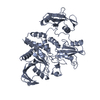
 リンク
リンク 集合体
集合体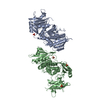
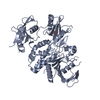
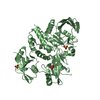
 要素
要素 Homo sapiens (ヒト) / 遺伝子: PTPN11, PTP2C, SHPTP2 / 発現宿主:
Homo sapiens (ヒト) / 遺伝子: PTPN11, PTP2C, SHPTP2 / 発現宿主: 
 X線回折 / 使用した結晶の数: 1
X線回折 / 使用した結晶の数: 1  試料調製
試料調製 シンクロトロン / サイト:
シンクロトロン / サイト:  NSLS
NSLS  / ビームライン: X25 / 波長: 1.1 Å
/ ビームライン: X25 / 波長: 1.1 Å 解析
解析 分子置換
分子置換 ムービー
ムービー コントローラー
コントローラー





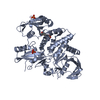
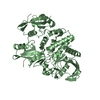


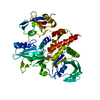
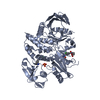
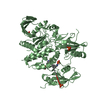
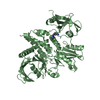
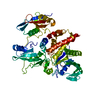


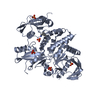

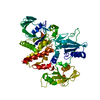

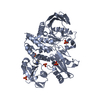

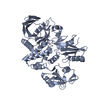
 PDBj
PDBj